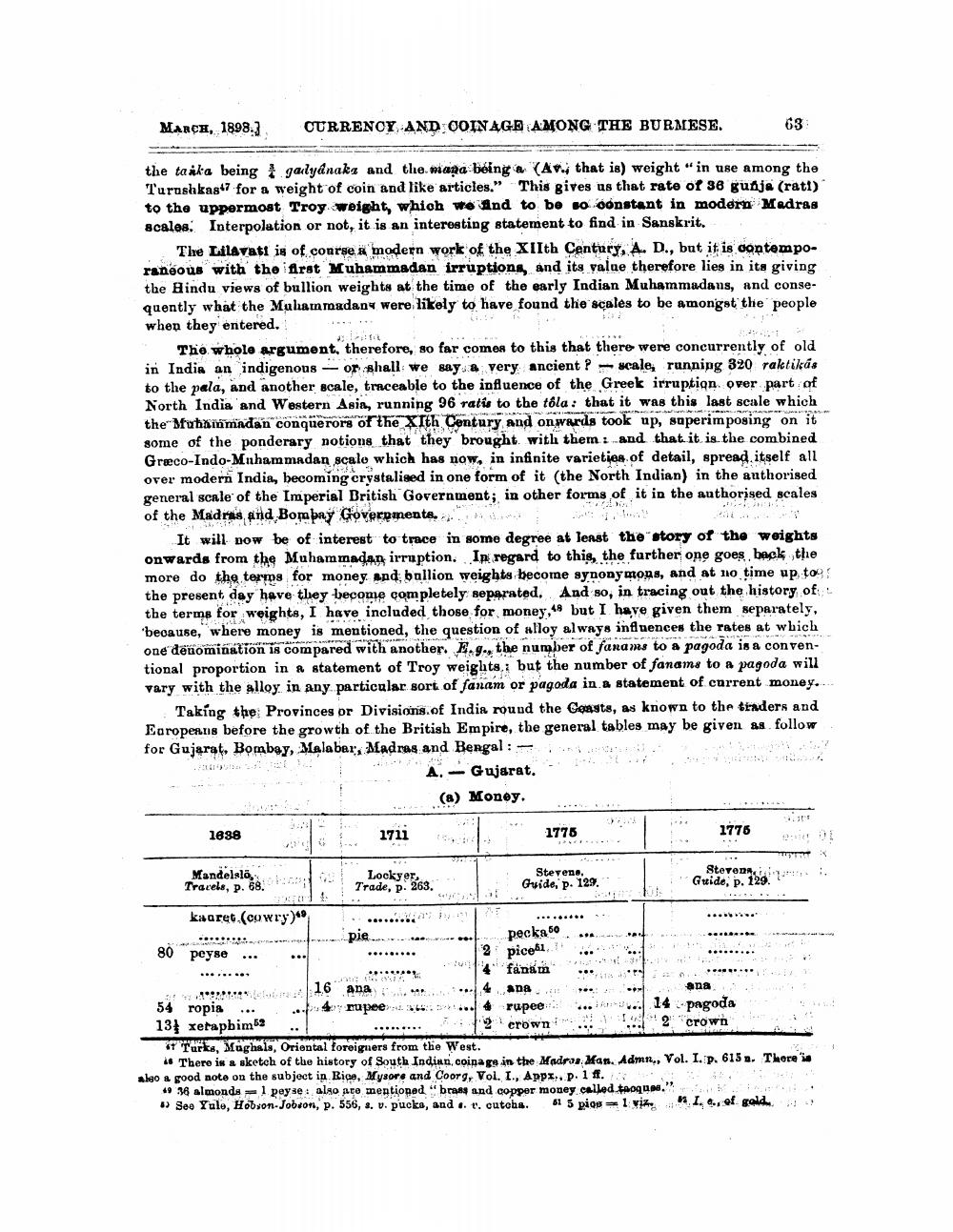________________
MARCH, 1898.3
CURRENCY AND OOINAGE AMONG THE BURMESE.
63
the taska being gailydnaka and the mana being a (Av. that is) weight in use among the Turuskkas*7 for a weight of coin and like articles." "This gives us that rate of 38 gunja (ratt) to the uppermost Troy weight, which we and to be so constant in modern Madras scales. Interpolation or not, it is an interesting statement to find in Sanskrit.
The Lilavati is of conrne a modern work of the XIIth Century, A. D., but it is contemporaneous with the first Muhammadan irruptions, and its value therefore lies in its giving the Hindu views of bullion weights at the time of the early Indian Muhammadans, and consequently what the Muhammadans were likely to have found the scales to be amongst the people when they entered,
The whole argument, therefore, so far comes to this that there were concurrently of old in India an indigenous - Or shall we say a very ancient ? scale, runnipg 320 raktikas to the pala, and another scale, traceable to the influence of the Greek irruption over part of North India and Western Asia, running 96 ratis to the tôla: that it was this last scale which the Muhinmadan conquerors of the XIth Century and onwards took up, superimposing on it some of the ponderary notions that they brought with them: and that it is the combined Greco-Indo-Muhammadan scalo which has now, in infinite varieties of detail, spread itself all over modern India, becoming crystalised in one form of it (the North Indian) in the anthorised general scale of the Imperial British Government; in other forms of it in the authorised scales of the Madras and Bombay Goveramente,
It will now be of interest to trace in some degree at least the story of the weights onwards from the Muhammadan irruption. la regard to this, the further one goes back the more do the terms for money and ballion weights become synonymous, and at no time up toe! the present day have they become completely separated. And so, in tracing out the history of the terms for weights, I have included those for money, but I have given them separately, because, where money is mentioned, the question of alloy always influences the rates at which one denomination is compared with another. E.g., the number of fanams to a pagoda is a conventional proportion in a statement of Troy weights, but the number of fanams to a pagoda will vary with the alloy. in any particular sort of fanam or pagoda in a statement of current money...
Taking the Provinces or Divisions of India round the Consts, as known to the traders and Earopennis before the growth of the British Empire, the general tables may be given as follow for Gujarat, Bombay, Malabar, Madras and Bengal: --
.
..? A. - Gujarat.
(8) Money.
1888
1711
1775
1776
Mandelslo,
Lockyer, Trade, p. 263.
Tracels, p. 68.
Steveno. Guide, p. 129.
Stevenni Guide, p. 129.
.
kaaret (co wry)" ... .
...
pie..............
pecka 50
80
peyse
*
2
***
picell
10 Ana .. ........ .ana
ana 54 ropis ... ...-4rupee
... 4 rupees . ...14 pagoda 13} xetapbim 52 .. ......... . crown
2 crown * Turka, Mughals, Oriental foreigners from the West.
* There is a sketch of the history of South Indian coinage in the Madras Man. Admn., Vol. I. p. 615 3. There in also a good note on the subject in Riga, Mysore and Coorg, Vol. I., Appx. p. 18. ** 36 almonds -1 peyse: algo pro mentioned brass and copper money called toqu.
. • Seo Yule, Hobson-Jobson, p. 556, 3. v. pucko, and .. t' cutoba. 615 pios 1 vim ... ef gold.




